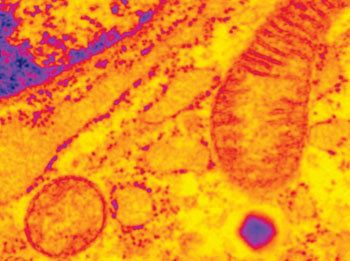Leaky Calcium Channels Promote Development of Diabetes
By LabMedica International staff writers
Posted on 20 Apr 2015
Chronic leakage from cellular calcium channels has been linked to a rare type of exercise-induced cardiac arrest and has been shown to cause glucose intolerance, suggesting that it might be involved in the development of type II diabetes.Posted on 20 Apr 2015
RyR2 (type 2 ryanodine receptor) is a Ca2+ release channel protein on the endoplasmic reticulum (ER) of several types of cells, including cardiomyocytes and pancreatic beta-cells. In cardiomyocytes, RyR2-dependent Ca2+ release is critical for excitation-contraction coupling; however, a functional role for RyR2 in beta-cell insulin secretion and diabetes mellitus has yet to be determined.

Image: Electron microscope image of a pancreatic beta cell, showing malformed mitochondria resulting from calcium leakage; the purple circle represents an insulin granule (Photo courtesy of Dr. Gaetano Santulli, Columbia University Medical Center).
To clarify the functional role of RyR2 in diabetes, investigators at Columbia University Medical Center (New York, NY, USA) took advantage of rare RyR2 mutations that were identified in patients with a genetic form of exercise-induced sudden death (catecholaminergic polymorphic ventricular tachycardia [CPVT]). As these mutations resulted in a “leaky” RyR2 channel, the investigators exploited them to assess RyR2 channel function in beta-cell dynamics.
They reported in the April 6, 2015, online edition of the Journal of Clinical Investigation that CPVT patients with mutant leaky RyR2 displayed glucose intolerance, which previously had not been diagnosed in patients with this syndrome. In mice, transgenic expression of CPVT-associated RyR2 resulted in impaired glucose homeostasis. An in-depth evaluation of pancreatic islets and beta-cells from these animals revealed intracellular Ca2+ leak via oxidized and nitrosylated RyR2 channels, activated ER stress response, mitochondrial dysfunction, and decreased fuel-stimulated insulin release.
Small molecule Rycal compounds were shown to enhance the binding of calstabin to leaky RyRs, repairing the leak and restoring normal function. Calstabin-2, which forms part of the RyR2 complex, helps to maintain the closed state of the channel during the diastolic phase of the cardiac cycle. However, in patients with heart failure, and in CPVT, depletion of calstabin-2 from the RyR2 complex caused calcium leakage that could trigger fatal ventricular tachyarrhythmia. By stabilizing RyR2, it may be possible to restore the strength of muscle contraction or neuronal function in chronic diseases.
"The advantage of a Rycal is that many drugs now used to treat type II diabetes increase the risk for low blood sugar and for heart disease," said senior author Dr. Andrew R. Marks, professor of physiology and cellular biophysics at Columbia University Medical Center. "Based on the mechanism of action of Rycals, we would not expect this drug to cause either of these. Also, Rycals are currently being tested in patients with heart disease and muscle disorders and have a good safety record so far."
"We have known that calcium in the pancreatic beta-cells plays a significant role in regulating insulin secretion, but calcium levels were thought to be controlled largely by the entry of calcium into the cell," said Dr. Marks. "It turns out that there is another mechanism in pancreatic beta-cells that also controls calcium. This mechanism involves RyR2 channels, and leaks in these channels can lead to impaired glucose tolerance. These findings open up a whole new area of research into the molecular underpinnings of pre-diabetes and diabetes and point to potential therapeutic targets."
Related Links:
Columbia University Medical Center













